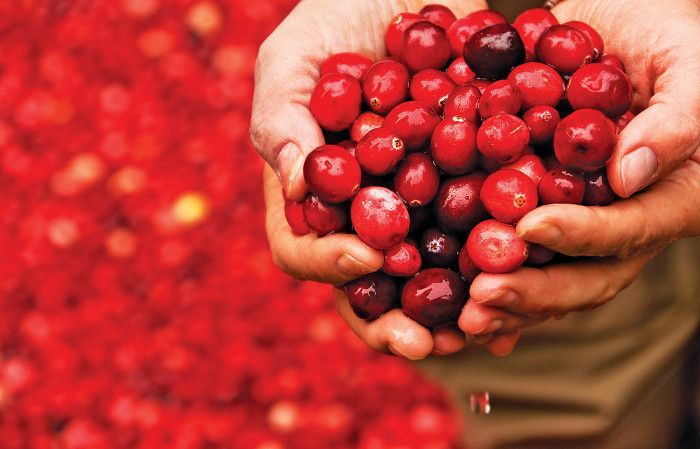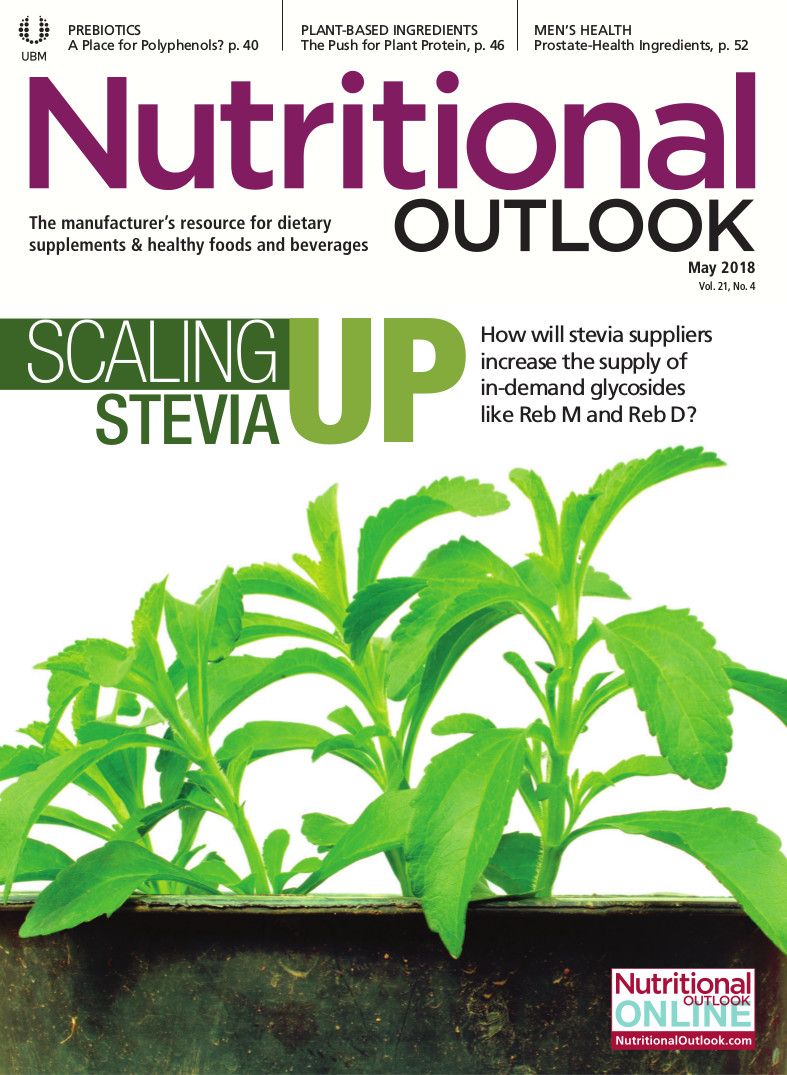Can Polyphenols Serve as Prebiotics?
Researchers are digging into the possible prebiotic potential of polyphenols, including those from cranberry.
Photo © iStockphoto.com/WilshireImages

Here’s a quick round of word association: I say “prebiotic” and you think…“Fiber,” right? If that was your choice, you’re not alone. Nor are you without reason: In 2006, FDA guidance1 not only reinforced the prevailing definition of prebiotics as “nondigestible food ingredients that beneficially affect the host by selectively stimulating the growth and/or activity of one or a limited number of bacteria in the colon”-that is, “fiber”-but singled out oligosaccharides as “commonly used” prebiotics, to boot. So it’s not surprising that when most of us think about what feeds our friendly intestinal flora, we think of fiber.
Now, however, emerging research suggests that this definition may in fact be too narrow. In short, it’s possible that some probiotic bacteria may receive aid and comfort from compounds that don’t fall under the historically fibrous prebiotic rubric. Case in point: polyphenols, which “are being recognized for their prebiotic potential in addition to their wider range of health benefits,” says Shaheen Majeed, president worldwide, Sabinsa (East Windsor, NJ).
Though evidence for polyphenols’ prebiotic potential remains nascent, the possibility it holds for synbiotic formulation deserves attention. So those in the know are keeping their eyes on polyphenols and the prebiotic science surrounding them. As Majeed says, “These effects are real, and polyphenols are here to make a difference in the prebiotic category.”
Polyphenolic Protection
It’s not as if polyphenols didn’t already deserve our love. These naturally occurring antioxidant phytochemicals-more than 8,000 of which have been identified in sources ranging from fruits and vegetables to tea, wine, chocolate, and olive oil-are the second-most abundant compounds in plants, trailing only carbohydrates.
As a class, they comprise stilbenes, lignans, phenolic acids, and flavonoids, and they exist, more or less, to protect their plant parents. But over the years, says Majeed, “research has suggested that polyphenols play a vital role in promoting our vitality and optimal health and wellness,” too, along with those of plants.
According to researchers, polyphenols’ bill of human health particulars runs from cardiovascular benefits, possible cancer prevention, and metabolic and blood sugar balance, to cognitive support, joint and bone health, weight management, a healthy inflammatory response, and-new to the list-optimal gut health.
Fiber Fundamentals
That’s a change of pace, as gut health had primarily been the province of probiotic bacteria and the prebiotic fibers that feed them. And that makes sense, because a preponderance of evidence affirms that probiotic bacteria are instrumental to a well-functioning gastrointestinal tract, and that prebiotic fiber encourages their proliferation.
“These bacteria are important as they may have several beneficial effects on the host, especially in terms of improving digestion and the effectiveness and intrinsic strength of the immune system,” says Stephen Lukawski, BA, MEd, global sales and marketing consultant, product development and partner, Fruit d’Or Nutraceuticals (Villeroy, QC, Canada). “Preliminary research has also demonstrated potential effects of probiotic bacteria on the absorption of calcium and other minerals, bowel acidity, and inflammatory bowel disease.”
As for the fibers that fuel them, those with the highest profiles as prebiotics include inulin, fructooligosaccharides (FOS), guar gum, and resistant starch. And the high profile these specific prebiotic ingredients enjoy, Majeed notes, is thanks in no small part to the “leverage given by FDA” in its aforementioned 2006 guidance on what a prebiotic is.
New Compound on the Block
“However,” Majeed continues, “over the years, newer ingredients have caught the attention of the industry, owing to their prebiotic benefits.” In fact, the International Scientific Association for Probiotics and Prebiotics in 2016 updated its definition and scope of prebiotics to encompass non-carbohydrate ingredients, Majeed notes.
And that’s where polyphenols come in. “Several studies have demonstrated that polyphenols play an important role in improving gut health by boosting the growth of beneficial bacteria in the intestine,” Majeed says. And whereas poor absorbability is often a drawback for a nutritional ingredient, the poor absorbability of polyphenols “becomes an advantage, as far their prebiotic positioning is concerned,” Majeed adds.
So how do polyphenols perform prebiotically? Their effectiveness, Majeed says, “is suggested to be due to their ability to stimulate the growth of beneficial microbiota while inhibiting that of pathogenic strains, and to their anti-adhesion activity against harmful pathogens. Overall, they’re believed to confer positive benefits by modulating gut microecology.”
Here Comes Cranberry
And while researchers have focused mainly on the flavone, flavonol, anthocyanidin, and catechin polyphenols found in fruits, vegetables, red wine, and green tea, Lukawski says it’s time for these compounds to “move over, as here comes cranberry, and it’s showing prebiotic benefits in the gut.”
To wit, a Sabinsa-sponsored study2 published in the International Journal of Food Science and Technology compared the prebiotic effect of Fruit d’Or’s proprietary Cran Naturelle cranberry seed powder versus FOS fiber on Sabinsa’s L-(+)-lactic acid–producing Bacillus coagulans MTCC 5856 probiotic preparation, marketed as LactoSpore.
The study’s results showed an increase in the viable B. coagulans MTCC 5856 count when the cranberry seed powder served as the sole nutrition source-demonstrating that the bacteria can actually ferment it. Additionally, under anaerobic conditions the cranberry seed powder inhibited growth of undesirable E. coli ATCC 25922 while supporting B. coagulans MTCC 5856 growth-suggesting that it contributes to a gastrointestinal environment favorable to the healthful probiotic. Finally, in vitro gastric acid and pancreatic enzyme digestibility tests showed that the cranberry seed powder resists gastric acid even better than FOS, though its non-digestibility to pancreatic enzymes equaled that of FOS, the companies say.
“It seems that the cranberry seed acts as a natural food source,” Lukawski says. And it’s not unreasonable to suspect that it would do so. The powder contains 20%-25% pure protein, 50% fiber, and, Lukawski continues, “all the essential amino acids. It’s also standardized to contain a minimum of 3% insoluble proanthocyanidin content. It seems to be the fuel the probiotics need to feed from, as it provides the carbon, nitrogen, and amino acids necessary to stimulate the strain’s hardiness and growth.” No wonder he calls the powder “a superfood for various probiotic strains.”
Cranberry Caveats
Along with previously published literature, this new study, Majeed says, “is encouraging and certainly expands the concept of prebiotics beyond non-digestible oligosaccharides to include polyphenols as attractive alternatives.” It also adds to a body of evidence suggesting that polyphenols’ health benefits are based on their microbial use-and on the metabolites thus produced-rather than on the parent molecules themselves.
“However,” Majeed concedes, “in comparison to oligosaccharides, the number of studies done on polyphenols is limited and, hence, more research is needed to ascertain their prebiotic potential.” So product developers and ingredient suppliers should exercise the usual caution when promoting polyphenols as prebiotics.
“Like any other synbiotic preparation,” Majeed says, “products including polyphenols as a prebiotic source would require the same level of checklist for the formulators to follow.” That means clean-labels demands still apply, “and when it comes to claims and use levels, companies should have enough research data to back those levels and claims,” he says. “More importantly, formulators should design products that meet customers’ expectations in delivery format, ease of delivery, benefits, and more.”
To Market, To Market
Some are already doing just that-starting with Sabinsa. Its LactoCran is a synbiotic preparation combining LactoSpore with Fruit d’Or’s Cran Naturelle cranberry seed powder, and Majeed believes it’s “well positioned to break through in the synbiotic market.”
Lukawski is also bullish on the prospects for the cranberry juice that his own company launched. Called Sun Cran Naturelle, it combines Fruit d’Or’s cranberry polyphenols with Taiyo International’s (Minneapolis) galactomannan-based guar fiber ingredient, marketed as Sunfiber. “When combined with the cranberry juice,” Lukawski says, “we’re now able to deliver a dual-function product for support of a healthy urinary tract and gut health. No one has ever done this combination, and we’re the first to market.” A study exploring its anti-adhesion properties is underway at Rutgers University, Lukawski adds, with results expected “sometime in April.”
Finally, he mentions a collaboration between his company and the International Agriculture Group (Mooresville, NC)-producers of NuBana, a resistant starch extracted from green bananas. “Green banana is a natural prebiotic fiber with scientifically proven benefits surrounding its resistant starch,” Lukawski says. “When formulated with our cranberry seed powder, it becomes a superfood prebiotic that provides a combination of protein, fiber, and amino acids.”
Sabinsa is even combining its B. coagulans probiotics with the cranberry-banana ingredient to create what Lukawski calls “a LactoCranBana brand that’s ideal for use in nutrition bars, yogurts, smoothies, shakes, and other dairy products.” He anticipates its availability in early summer.
With all this to look forward to, it’s no wonder Lukawski is “excited for the future of the prebiotic opportunities for polyphenols,” he says. “When combining polyphenol prebiotics with probiotics, we’re entering a whole new space and category.”
Also read:
Cranberry Tackles Probiotic Bar and Juice Powders in New Launches
Cranberry Plus Probiotic Tackles First Gummy
Prebiotic Ingredients: Nondigestible Oligosaccharides
References:
- FDA Draft Guidance. “Guidance for Industry on Complementary and Alternative Medicine Products and Their Regulation by the Food and Drug Administration.” www.fda.gov/downloads/RegulatoryInformation/Guidances/UCM145405.pdf. December 2006.
- Majeed M et al., “Cranberry seed fibre: a promising prebiotic fibre and its fermentation by the probiotic Bacillus coagulans MTCC 5856,” International Journal of Food Science and Technology. Published online February 17, 2018.

Prinova acquires Aplinova to further increase its footprint in Latin America
April 7th 2025Prinova has recently announced the acquisition of Brazilian ingredients distributor Aplinova, which is a provider of specialty ingredients for a range of market segments that include food, beverage, supplements, and personal care.






















